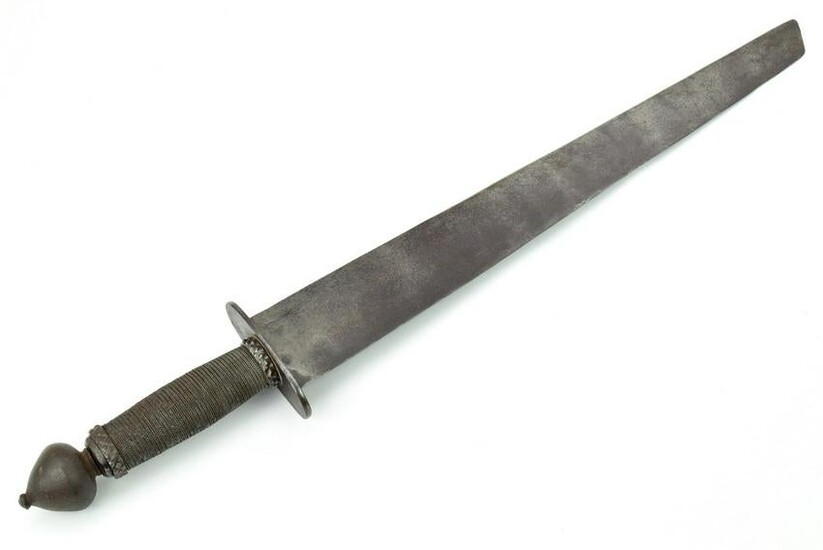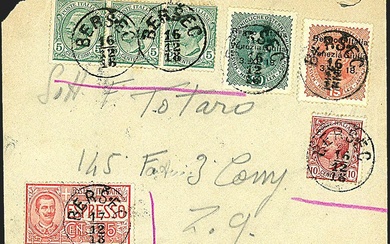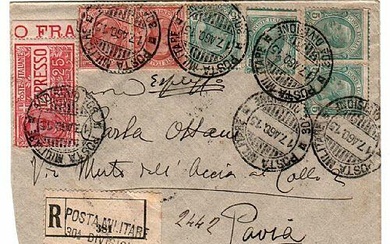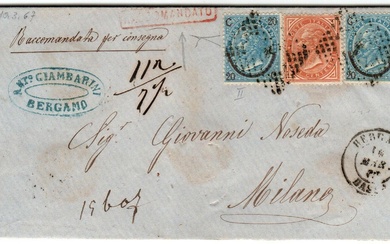Rare 15th-17th C. Italian or French FALCHION Short
Rare 15th-17th C. Italian or French FALCHION Short Sword. A powerful and robust battle sword, built for most efficient business, having a broad straight single edged blade tapering slightly to a distinctive cleaver like tip. Hilt with strong iron mounts and braid steel wire grip bordered by very nicely executed cut steel ring-bands. Below is some History on this particular type of early Falchion swords.From Wikipedia, the free encyclopediaFalchion :Falchion – Italy, 15th centuryType: Sword Place of origin: FranceProduction history :Produced13th century – 16th centuryVariantsSee Elmslie typologySpecifications :Blade typegenerally single-edged, curved (occasionally straight)Hilt typeafter an arming swordA falchion (/ˈfÉ”Ëltʃən/; Old French: fauchon; Latin: falx, "sickle") is a one-handed, single-edged sword of European origin, whose design is reminiscent of the modern machete. Falchions are found in different forms from around the 13th century up to and including the 16th century. In some versions the falchion looks rather like the seax and later the sabre, and in other versions the form is irregular or like a machete with a crossguard.Types :The blade designs of falchions varied widely across the continent and through the ages. They almost always included a single edge with a slight curve on the blade towards the point on the end and most were also affixed with a quilloned crossguard for the hilt in the manner of the contemporary arming swords. Unlike the double-edged swords of Europe, few actual swords of this type have survived to the present day; fewer than a dozen specimens are currently known. A number of weapons superficially similar to the falchion existed in Western Europe, including the Messer, hanger and the backsword. Two basic types of falchion can be identified:Cleaver falchions :One of the few surviving falchions (the Conyers falchion) is shaped very much like a large meat cleaver, or large bladed machete. This type is also illustrated in art. The type seems to be confined to the 13th and 14th centuries. However apart from the profile they present a very thin blade, often only 1.2 mm thick spines, 7 cm from the point with a slight taper leading near to the edge before dropping into a secondary bevel which brings the blade to a very acute edge while maintaining some durability. Current theories are that they were the anti-cloth armour weapon of the day.Cusped falchions :The majority of the depictions in art reflect a design similar to that of the großes Messer. The Thorpe Falchion, a surviving example from England's 13th century, was just under 904 grams (1.99 lb) in weight. Of its 956 millimetres (37.6 inches) length, 803 millimetres (31.6 in) are the straight blade which bears a cusped or flare-clipped tip similar to the much later kilij of Turkey. This blade style may have been influenced by the Turko-Mongol sabres that had reached the borders of Europe by the 13th century. This type of sword continues in use into the 16th century. It is now debated that it is an actual influence of the Turko-Mongol type sabres. It is now categorized as an independent development as the 13th century sabres don't have this type of cusp.Other Falchions :Falchion with long, wooden haft, from the Morgan Bible.In addition, there are a group of 13th- and early 14th-century weapons sometimes identified with the falchion. These have a falchion-like blade mounted on a wooden shaft 1–2 ft (30–61 cm) long, sometimes ending in a curve like an umbrella. These are seen in numerous illustrations in the mid-13th-century Maciejowski Bible.Modern classificationOngoing research by James Elmslie has produced a typology covering both falchion and messer blade designs. Under this system all known falchions can be described as types 1 - 5 (with subtypes a - e used for any given type) as well as 5 levels of curvature.Status :A falchion had a lower quality and status than the longer, more expensive swords, as almost none of them survive today. Falchions are sometimes misunderstood and thought of as being similar to machetes; however, the ancient falchions that have been discovered are incredibly thin and on average, lighter than a double-edged blade. These weapons were therefore not cleaving or chopping weapons similar to the machete, but quick slashing weapons more similar to shamshir or sabres despite their wide blade. While falchions are commonly thought to be peasants' weapons this is not always the case; the Conyers falchion belonged to a landed family, and the falchion is shown in illustrations of combat between mounted knights. Some later falchions were ornate and used by the nobility; there is an elaborately engraved and gold plated falchion from the 1560s in the Wallace Collection, engraved with the personal coat of arms of Cosimo I de' Medici, Grand Duke of Tuscany.Sword is 32", blade is 24,5". Widthest part is - 3".
[ translate ]View it on
Estimate
Time, Location
Auction House
Rare 15th-17th C. Italian or French FALCHION Short Sword. A powerful and robust battle sword, built for most efficient business, having a broad straight single edged blade tapering slightly to a distinctive cleaver like tip. Hilt with strong iron mounts and braid steel wire grip bordered by very nicely executed cut steel ring-bands. Below is some History on this particular type of early Falchion swords.From Wikipedia, the free encyclopediaFalchion :Falchion – Italy, 15th centuryType: Sword Place of origin: FranceProduction history :Produced13th century – 16th centuryVariantsSee Elmslie typologySpecifications :Blade typegenerally single-edged, curved (occasionally straight)Hilt typeafter an arming swordA falchion (/ˈfÉ”Ëltʃən/; Old French: fauchon; Latin: falx, "sickle") is a one-handed, single-edged sword of European origin, whose design is reminiscent of the modern machete. Falchions are found in different forms from around the 13th century up to and including the 16th century. In some versions the falchion looks rather like the seax and later the sabre, and in other versions the form is irregular or like a machete with a crossguard.Types :The blade designs of falchions varied widely across the continent and through the ages. They almost always included a single edge with a slight curve on the blade towards the point on the end and most were also affixed with a quilloned crossguard for the hilt in the manner of the contemporary arming swords. Unlike the double-edged swords of Europe, few actual swords of this type have survived to the present day; fewer than a dozen specimens are currently known. A number of weapons superficially similar to the falchion existed in Western Europe, including the Messer, hanger and the backsword. Two basic types of falchion can be identified:Cleaver falchions :One of the few surviving falchions (the Conyers falchion) is shaped very much like a large meat cleaver, or large bladed machete. This type is also illustrated in art. The type seems to be confined to the 13th and 14th centuries. However apart from the profile they present a very thin blade, often only 1.2 mm thick spines, 7 cm from the point with a slight taper leading near to the edge before dropping into a secondary bevel which brings the blade to a very acute edge while maintaining some durability. Current theories are that they were the anti-cloth armour weapon of the day.Cusped falchions :The majority of the depictions in art reflect a design similar to that of the großes Messer. The Thorpe Falchion, a surviving example from England's 13th century, was just under 904 grams (1.99 lb) in weight. Of its 956 millimetres (37.6 inches) length, 803 millimetres (31.6 in) are the straight blade which bears a cusped or flare-clipped tip similar to the much later kilij of Turkey. This blade style may have been influenced by the Turko-Mongol sabres that had reached the borders of Europe by the 13th century. This type of sword continues in use into the 16th century. It is now debated that it is an actual influence of the Turko-Mongol type sabres. It is now categorized as an independent development as the 13th century sabres don't have this type of cusp.Other Falchions :Falchion with long, wooden haft, from the Morgan Bible.In addition, there are a group of 13th- and early 14th-century weapons sometimes identified with the falchion. These have a falchion-like blade mounted on a wooden shaft 1–2 ft (30–61 cm) long, sometimes ending in a curve like an umbrella. These are seen in numerous illustrations in the mid-13th-century Maciejowski Bible.Modern classificationOngoing research by James Elmslie has produced a typology covering both falchion and messer blade designs. Under this system all known falchions can be described as types 1 - 5 (with subtypes a - e used for any given type) as well as 5 levels of curvature.Status :A falchion had a lower quality and status than the longer, more expensive swords, as almost none of them survive today. Falchions are sometimes misunderstood and thought of as being similar to machetes; however, the ancient falchions that have been discovered are incredibly thin and on average, lighter than a double-edged blade. These weapons were therefore not cleaving or chopping weapons similar to the machete, but quick slashing weapons more similar to shamshir or sabres despite their wide blade. While falchions are commonly thought to be peasants' weapons this is not always the case; the Conyers falchion belonged to a landed family, and the falchion is shown in illustrations of combat between mounted knights. Some later falchions were ornate and used by the nobility; there is an elaborately engraved and gold plated falchion from the 1560s in the Wallace Collection, engraved with the personal coat of arms of Cosimo I de' Medici, Grand Duke of Tuscany.Sword is 32", blade is 24,5". Widthest part is - 3".
[ translate ]






